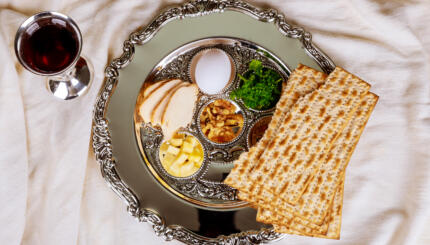Passover 2018 begins at sundown on Friday, March 30, and ends Saturday evening, April 7. The first Passover seder is on the evening of March 30, and the second Passover seder takes place on the evening of March 31.
What is Passover?
Passover is a festival of freedom. It commemorates the Israelites’ Exodus from Egypt and their transition from slavery to freedom.
The main ritual of Passover is the seder, a festive meal that involves the re-telling of the Exodus through stories and song and the consumption of ritual foods, including matzah and maror (bitter herbs). The seder takes place on the first night of the holiday, and outside Israel on the second night as well.
The seder’s rituals and other readings are outlined in the Haggadah, a book that provides a script for the seder. Today, many different versions of the Haggadah are available in print and online, or you can create your own.
With your help, My Jewish Learning can provide endless opportunities for learning, connection and discovery.
What are some Passover practices?
The central Passover practice is a set of intense dietary changes, mainly the absence of hametz, or foods with leaven. (Ashkenazi Jews also avoid kitniyot, a category of food that includes legumes.) In recent years, many Jews have compensated for the lack of grain by cooking with quinoa, although not all recognize it as kosher for Passover. The ecstatic cycle of psalms called Hallel is recited during the seder and during morning prayers. Additionally, Passover commences a 49-day period called the Omer, which recalls the count between offerings brought to the ancient Temple in Jerusalem. This count culminates in the holiday of Shavuot, the anniversary of the receiving of the Torah at Sinai.
What foods do we eat on Passover?
Matzah, or unleavened bread, is the main food of Passover. You can purchase it in numerous stores or make your own. But the holiday has many other traditional foods, from haroset (a mixture of fruit, nuts, wine, and cinnamon) to matzah ball soup. The absence of leavening calls upon a cook to employ all of their culinary creativity. View our extensive collection of Passover recipes here, or check out The Nosher, our lively food blog!
Haggadah
Pronounced: huh-GAH-duh or hah-gah-DAH, Origin: Hebrew, literally "telling" or "recounting." A Haggadah is a book that is used to tell the story of the Exodus at the Passover seder. There are many versions available ranging from very traditional to nontraditional, and you can also make your own.
seder
Pronounced: SAY-der, Origin: Hebrew, literally "order"; usually used to describe the ceremonial meal and telling of the Passover story on the first two nights of Passover. (In Israel, Jews have a seder only on the first night of Passover.)
afikomen
Pronounced: ah-fee-KOH-men, Origin: Greek, a piece of matzah that is hidden during the Passover seder, found after dinner and eaten as dessert at the end of the meal.
Pesach
Pronounced: PAY-sakh, also PEH-sakh. Origin: Hebrew, the holiday of Passover.
kitniyot
Pronounced: kit-nee-YOTE, Origin: Hebrew, meaning "little things," the term here refers to legumes, corn, rice and other non-hametz foods prohibited for use on Passover by some Ashkenazic rabbis in the medieval period. Many Sephardic Jews (and Conservative Jews) do allow them on Passover.
hametz
Pronounced: khah-METZ or KHUH-metz, Origin: Hebrew, bread or any food that has been leavened or contains a leavening agent. Hametz is prohibited on Passover.



